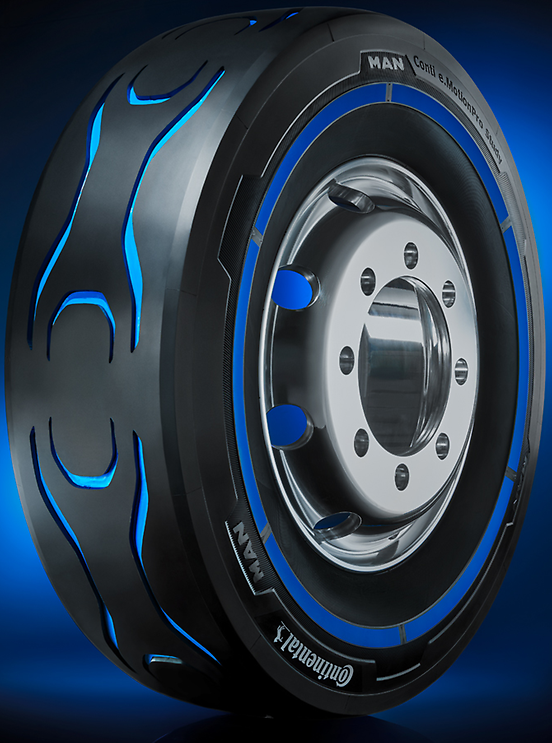Electric truck tires will be the same … but different
Tires will always be round and black, but don’t let that fool you. The operating characteristics of battery-electric drivetrains — coupled with heavy batteries — will change the way tires for electric trucks are built. In addition to providing good traction, low rolling resistance and long miles to removal, BEV drive tires will need to withstand higher torque loads, while steer tires will be subject to higher vertical loads than traditional tires.

Those operational factors will apply to Class 8 truck as well as the lighter Class 5 and 6 delivery trucks. The tare weights of the vehicles will increase, probably compromising payloads slightly, but that will also tighten the margin on load carrying capacities for some tires, particularly steer tires.
Torque loads on drive tires will not only increase thanks to the higher output of electric motors compared to internal combustion engines, but regenerative braking will impart torsional forces on tires in the opposite direction. This will affect tire wear and sidewalls. And this will be more of a consideration in high stop-and-go applications.
“Higher torque on the drive axle will result in higher wear rate,” says Hinnerk Kaiser, Continental’s head of product development. “In addition, a higher share of braking torque can increase the risk of irregular wear phenomena — heel and toe wear. Both criteria are key performance factors for a drive tire development anyway, but we have to set a higher focus for electric trucks. This can lead to an adapted pattern and contour layout, such as groove design, void distribution, tread pattern depths.”
We may also have to rethink “directionality” in drive tires. Aside from being logistically annoying – getting the right tire going in the right direction during installation – such tires were designed to handle torque from only one direction.
“When they design directional tires, they don’t look at brake torques,” says Goodyear’s commercial technology director, Mahesh Kavaturu. “It’s not a constant feature, but regenerative braking will produce more sustained brake torques.”
While OEMs and driveline engineers will come up with ways to manage or mitigate torque at launch, the additional brake torque due to constant regenerative braking will introduce additional energy to the tire, manifesting itself as tread wear.
Minimize wear, improve performance
“That’s where we really have to innovate,” says Kavaturu. “We are focused on bringing new reinforcement materials like silica, carbon, black, as well as new steel reinforcements to our tires to ensure that in the face of all those additional demands, we can maintain treadwear to the degree experienced by ICE [internal combustion engine] vehicles.”
While fleets operating electric vehicles may tolerate shorter tread life or higher degrees of irregular wear during the development phase, they will expect those issues to be sorted out in the near term. But fleets and the truck makers will also be looking for even lower rolling resistance from their BEV tires to prolong battery life.
“While rolling resistance is a factor for diesel-powered vehicles for fuel efficiency, for electric trucks it relates to the range of miles the vehicle can travel before it needs to be recharged,” notes Michelin field engineer, Mike Steiner. “Rolling resistance may take on an even higher level of importance in order to meet the range needs of the fleets operating the electric trucks.”
The quest for lower rolling resistance could take us into unknown territory. In testing at its research and development facilities in Europe, Continental has been experimenting with “tall and narrow” tires as a way to reduce rolling resistance. A hand-built prototype 205/65R22 tire has already proven successful improving rolling resistance, but the size is not something we’re likely to adopt readily here in North America.
“That particular size was chosen based on preferences from [European truck maker] MAN for their concept electric vehicle,” a Continental spokesperson told Today’s Trucking. “So far, OEMs have not indicated that this tire size will be used on serial production vehicles. However, we do anticipate that tall and narrow tires will become more popular on electric trucks. Tires with a large diameter can help to keep rolling resistance down on account of their size alone, amplifying the effects of tread compounding and other initiatives.”
Repositioning and retreading
While we are still in early days of development for battery-electric-vehicle tires, there’s no need to begin fretting about repositioning those tires to trailer positions, or even about retreadability. They will both be design considerations. Kavaturu indicated that maintaining traditional tire sizing is vital.
That said, if, as Goodyear suggests, steer tires migrate out from 11-inch-wide treads to 12 or 12.5 inches, there will be mixing concerns, which might limit repositioning opportunities and ultimately the value in retreading such tires. The same goes for tall and narrow tires, should they find their way into service here.
Today we enjoy tires that can be repurposed, repositioned and retreaded. If we wind up with short, fat steer tires and tall narrow drive tires, what will become of the traditional feedstock for trailer tires? But it’s probably a bit too early to worry about that.
Have your say
This is a moderated forum. Comments will no longer be published unless they are accompanied by a first and last name and a verifiable email address. (Today's Trucking will not publish or share the email address.) Profane language and content deemed to be libelous, racist, or threatening in nature will not be published under any circumstances.